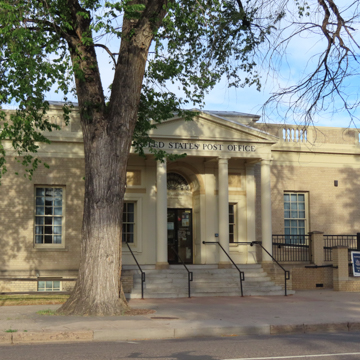The pedimented portico, front door fanlight, and roof-top balustrade of the post office say Federal Revival style, which is usually associated with eastern Colonial Revival architecture but is rarely seen in western states. A coffered barrel vault fronts the entrance, whose leaded transom and tall, flanking windows reaffirm the Colonial Revival appearance. The side elevations have arched windows with side lights which echo the entry. A later rear addition matches the light tan brick and the Flemish bond pattern of the original. The interior has been unfortunately remodeled.
James A. Wetmore served as acting Supervising Architect of the Treasury from 1912 to 1913 and between 1915 and 1934. In 1915 Secretary of the Treasury William McAdoo recommended that more rational financial criteria be applied to public building projects. This post office was built just before standards were implemented to limit size and level of ornamentation of post office buildings with an eye to postal receipts and site value.














